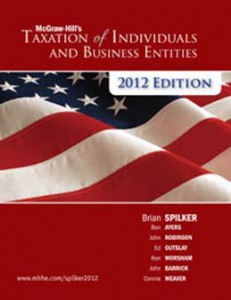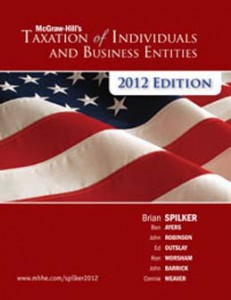Test Bank for Taxation of Individuals and Business Entities 2012, 3rd Edition: Spilker

Product details:
- ISBN-10 : 0077924525
- ISBN-13 : 978-0077924522
- Author: Spilker
McGraw-Hill’s Taxation Series continues to provide a unique, innovative, and engaging learning experience for students studying taxation. The breadth of the topical coverage, the storyline approach to presenting the material, the emphasis on the tax and nontax consequences of multiple parties involved in transactions, and the integration of financial and tax accounting topics make this book ideal for the modern tax curriculum.
With over 275 schools adopting the 3rd edition, McGraw-Hill’s Taxation of Individuals and Business Entities resonates with instructors who were in need of a bold and innovative approach to teaching tax. 280 professors have contributed 250 book reviews, in addition to 17 focus groups and symposia. These instructors were impressed on the book’s organization, pedagogy, and unique features that are a testament to the grassroots nature of this book’s development.
Table contents:
- 1 An Introduction to Tax
- Who Cares about Taxes and Why?
- What Qualifies as a Tax?
- How to Calculate a Tax
- Different Ways to Measure Tax Rates
- Tax Rate Structures
- Proportional Tax Rate Structure
- Progressive Tax Rate Structure
- Regressive Tax Rate Structure
- Types of Taxes
- Federal Taxes
- State and Local Taxes
- Implicit Taxes
- Evaluating Alternative Tax Systems
- Sufficiency
- Equity
- Certainty
- Convenience
- Economy
- Evaluating Tax Systems—The Trade-Offs
- Conclusion
- 2 Tax Compliance, the IRS, and Tax Authorities
- Taxpayer Filing Requirements
- Tax Return Due Date and Extensions
- Statute of Limitations
- IRS Audit Selection
- Types of Audits
- Tax Law Sources
- Legislative Sources: Congress and the Constitution
- Judicial Sources: The Courts
- Administrative Sources: The U.S. Treasury
- Tax Research
- Step 1: Understand Facts
- Step 2: Identify Issues
- Step 3: Locate Relevant Authorities
- Step 4: Analyze Tax Authorities
- Step 5: Document and Communicate the Results
- Tax Professional Responsibilities
- Taxpayer and Tax Practitioner Penalties
- Conclusion
- 3 Tax Planning Strategies and Related Limitations
- Basic Tax Planning Overview
- Timing Strategies
- Present Value of Money
- The Timing Strategy When Tax Rates Are Constant
- The Timing Strategy When Tax Rates Change
- Income-Shifting Strategies
- Transactions between Family Members and Limitations
- Transactions between Owners and Their Businesses and Limitations
- Income Shifting across Jurisdictions and Limitations
- Conversion Strategies
- Limitations of Conversion Strategies
- Additional Limitations to Tax Planning Strategies: Judicially Based Doctrines
- Tax Avoidance versus Tax Evasion
- Conclusion
- 4 Individual Income Tax Overview, Dependents, and Filing Status
- The Individual Income Tax Formula
- Gross Income
- Character of Income
- Deductions
- Income Tax Calculation
- Other Taxes
- Tax Credits
- Tax Prepayments
- Dependents of the Taxpayer
- Dependency Requirements
- Filing Status
- Married Filing Jointly and Married Filing Separately
- Qualifying Widow or Widower (Surviving Spouse)
- Single
- Head of Household
- Summary of Income Tax Formula
- Conclusion
- 5 Gross Income and Exclusions
- Realization and Recognition of Income
- What Is Included in Gross Income?
- Other Income Concepts
- When Do Taxpayers Recognize Income?
- Who Recognizes the Income?
- Types of Income
- Income from Services
- Income from Property
- Other Sources of Gross Income
- Exclusion Provisions
- Common Exclusions
- Education-Related Exclusions
- Exclusions That Mitigate Double Taxation
- Sickness and Injury-Related Exclusions
- Deferral Provisions
- Income Summary
- Conclusion
- 6 Individual Deductions
- Deductions for AGI
- Deductions Directly Related to Business Activities
- Deductions Indirectly Related to Business Activities
- Deductions Subsidizing Specific Activities
- Summary: Deductions for AGI
- Deductions from AGI: Itemized Deductions
- Medical Expenses
- Taxes
- Interest
- Charitable Contributions
- Casualty and Theft Losses on Personal-Use Assets
- Other Itemized Deductions
- Summary of Itemized Deductions
- The Standard Deduction
- Standard Deduction
- Deduction for Qualified Business Income
- Deduction for Qualified Business Income
- Limitations
- Taxable Income Summary
- Conclusion
- 7 Investments
- Investments Overview
- Portfolio Income: Interest and Dividends
- Interest
- Dividends
- Portfolio Income: Capital Gains and Losses
- Types of Capital Gains and Losses
- Limits for Capital Loss Deductions
- Balancing Tax Planning Strategies for Capital Assets with Other Goals
- Portfolio Income Summary
- Investment Interest Expense
- Net Investment Income Tax
- Passive Activity Income and Losses
- Passive Activity Definition
- Income and Loss Categories
- Rental Real Estate Exception to the Passive Activity Loss Rules
- Net Investment Income Tax on Net Passive Income
- Conclusion
- 8 Individual Income Tax Computation and Tax Credits
- Regular Federal Income Tax Computation
- Tax Rate Schedules
- Marriage Penalty or Benefit
- Exceptions to the Basic Tax Computation
- Alternative Minimum Tax
- Alternative Minimum Tax Formula
- Additional Taxes
- Employment and Self-Employment Taxes
- Tax Credits
- Nonrefundable Personal Credits
- Refundable Personal Credits
- Business Tax Credits
- Tax Credit Summary
- Credit Application Sequence
- Taxpayer Prepayments and Filing Requirements
- Prepayments
- Filing Requirements
- Tax Summary
- Conclusion
- 9 Business Income, Deductions, and Accounting Methods
- Business Gross Income
- Gross Receipts Test for Determining Small Businesses
- Business Deductions
- Ordinary and Necessary
- Reasonable in Amount
- Limitations on Business Deductions
- Expenditures against Public Policy
- Political Contributions and Lobbying Costs
- Capital Expenditures
- Expenses Associated with the Production of Tax-Exempt Income
- Personal Expenditures
- Mixed-Motive Expenditures
- Limitation on Business Interest Deductions
- Losses on Dispositions of Business Property
- Business Casualty Losses
- Accounting Periods
- Accounting Methods
- Financial and Tax Accounting Methods
- Overall Accounting Method
- Accrual Income
- Taxation of Advance Payments of Income (Unearned Income)
- Inventories
- Accrual Deductions
- Comparison of Accrual and Cash Methods
- Adopting an Accounting Method
- Changing Accounting Methods
- Conclusion
- 10 Property Acquisition and Cost Recovery
- Cost Recovery and Tax Basis for Cost Recovery
- Basis for Cost Recovery
- Depreciation
- Personal Property Depreciation
- Calculating Depreciation for Personal Property
- Real Property
- Special Rules Relating to Cost Recovery
- Depreciation for the Alternative Minimum Tax
- Depreciation Summary
- Amortization
- Section 197 Intangibles
- Organizational Expenditures and Start-Up Costs
- Research and Experimentation Expenditures
- Patents and Copyrights
- Amortizable Intangible Asset Summary
- Depletion
- Conclusion
- 11 Property Dispositions
- Dispositions
- Amount Realized
- Determination of Adjusted Basis
- Realized Gain or Loss on Disposition
- Recognized Gain or Loss on Disposition
- Character of Gain or Loss
- Ordinary Assets
- Capital Assets
- Section 1231 Assets
- Depreciation Recapture
- Section 1245 Property
- Section 1250 Depreciation Recapture for Real Property
- Other Provisions Affecting the Rate at Which Gains Are Taxed
- Unrecaptured §1250 Gain for Individuals
- Characterizing Gains on the Sale of Depreciable Property to Related Persons
- Calculating Net §1231 Gains or Losses
- Section 1231 Look-Back Rule
- Gain or Loss Summary
- Tax-Deferred Transactions
- Like-Kind Exchanges
- Involuntary Conversions
- Installment Sales
- Gains Ineligible for Installment Reporting
- Other Tax-Deferred Provisions
- Related-Person Loss Disallowance Rules
- Conclusion
- 12 Compensation
- Salary and Wages
- Employee Considerations for Salary and Wages
- Employer Considerations for Salary and Wages
- Equity-Based Compensation
- Stock Options
- Restricted Stock
- Equity-Based Compensation Summary
- Fringe Benefits
- Taxable Fringe Benefits
- Nontaxable Fringe Benefits
- Tax Planning with Fringe Benefits
- Fringe Benefits Summary
- Conclusion
- 13 Retirement Savings and Deferred Compensation
- Employer-Provided Qualified Plans
- Defined Benefit Plans
- Vesting
- Distributions
- Nontax Considerations
- Defined Contribution Plans
- Employer Matching
- Contribution Limits
- Vesting
- After-Tax Cost of Contributions to Traditional (non-Roth) Defined Contribution Plans
- Distributions from Traditional Defined Contribution Plans
- After-Tax Rates of Return for Traditional Defined Contribution Plans
- Roth 401(k) Plans
- Comparing Traditional Defined Contribution Plans and Roth 401(k) Plans
- Nonqualified Deferred Compensation Plans
- Nonqualified Plans versus Qualified Defined Contribution Plans
- Employee Considerations
- Employer Considerations
- Individually Managed Qualified Retirement Plans
- Individual Retirement Accounts
- Traditional IRAs
- Roth IRAs
- Converting a Traditional IRA to a Roth IRA
- Comparing Traditional and Roth IRAs
- Self-Employed Retirement Accounts
- Simplified Employee Pension (SEP) IRA
- Individual 401(k) Plans
- Saver’s Credit
- Conclusion
- 14 Tax Consequences of Home Ownership
- Is a Dwelling Unit a Principal Residence, Residence, or Nonresidence?
- Personal Use of the Home
- Exclusion of Gain on Sale of Personal Residence
- Home Mortgage Interest Deduction
- Real Property Taxes
- Rental Use of the Home
- Residence with Minimal Rental Use
- Residence with Significant Rental Use (Vacation Home)
- Nonresidence (Rental Property)
- Business Use of the Home
- Direct versus Indirect Expenses
- Limitations on Deductibility of Expenses
- Conclusion
- 15 Business Entities Overview
- Business Entity Legal Classification and Nontax Characteristics
- Legal Classification
- Nontax Characteristics
- Business Entity Tax Classification
- Business Entity Tax Characteristics
- Taxation of Business Entity Income
- Converting to Other Business Entity Types
- Conclusion
- 16 Corporate Operations
- Corporate Taxable Income Formula
- Accounting Periods and Methods
- Computing Corporate Taxable Income
- Book–Tax Differences
- Corporate-Specific Deductions and Associated Book–Tax Differences
- Taxable Income Summary
- Corporate Income Tax Liability
- Compliance
- Corporate Tax Return Due Dates and Estimated Taxes
- Conclusion
- 17 Accounting for Income Taxes
- Accounting for Income Taxes and the Income Tax Provision Process
- Why Is Accounting for Income Taxes So Complex?
- Objectives of ASC 740
- The Income Tax Provision Process
- Calculating a Company’s Income Tax Provision
- Step 1: Adjust Pretax Net Income for All Permanent Differences
- Step 2: Identify All Temporary Differences andTax Carryover Amounts
- Identifying Taxable and Deductible Temporary Differences
- Step 3: Compute the Current Income Tax Expense or Benefit
- Step 4: Determine the Ending Balances in the Balance Sheet Deferred Tax Asset and Liability Accounts
- Determining Whether a Valuation Allowance Is Needed
- Step 5: Evaluate the Need for a Valuation Allowance for Gross Deferred Tax Assets
- Determining the Need for a Valuation Allowance
- Step 6: Calculate the Deferred Income Tax Expense or Benefit
- Accounting for Uncertainty in Income Tax Positions
- Step 7: Evaluate the Need for an Uncertain Tax Benefit Reserve
- Application of ASC Topic 740 to Uncertain Tax Positions
- Subsequent Events
- Interest and Penalties
- Disclosures of Uncertain Tax Positions
- Schedule UTP (Uncertain Tax Position) Statement
- Financial Statement Disclosure and Computing a Corporation’s Effective Tax Rate
- Balance Sheet Classification
- Income Tax Footnote Disclosure
- Interim Period Effective Tax Rates
- FASB Projects Related to Accounting for Income Taxes
- Conclusion
- 18 Corporate Taxation: Nonliquidating Distributions
- Taxation of Property Distributions
- Determining the Dividend Amount from Earnings and Profits
- Overview
- Dividends Defined
- Computing Earnings and Profits
- Ordering of E&P Distributions
- Distributions of Noncash Property to Shareholders
- Stock Distributions
- Tax Consequences to Shareholders Receiving a Stock Distribution
- Stock Redemptions
- The Form of a Stock Redemption
- Redemptions That Reduce a Shareholder’s Ownership Interest
- Tax Consequences to the Distributing Corporation
- Partial Liquidations
- Conclusion
- 19 Corporate Formation, Reorganization, and Liquidation
- Review of the Taxation of Property Dispositions
- Tax-Deferred Transfers of Property to a Corporation
- Transactions Subject to Tax Deferral
- Meeting the Section 351 Tax Deferral Requirements
- Tax Consequences to Shareholders
- Tax Consequences When a Shareholder Receives Boot
- Assumption of Shareholder Liabilities by the Corporation
- Tax Consequences to the Transferee Corporation
- Other Issues Related to Incorporating an Ongoing Business
- Contributions to Capital
- Section 1244 Stock
- Taxable and Tax-Deferred Corporate Acquisitions
- The Acquisition Tax Model
- Tax Consequences to a Corporate Acquisition
- Taxable Acquisitions
- Tax-Deferred Acquisitions
- Judicial Doctrines That Underlie All Tax-Deferred Reorganizations
- Type A Asset Acquisitions
- Type B Stock-for-Stock Reorganizations
- Complete Liquidation of a Corporation
- Tax Consequences to the Shareholders in a Complete Liquidation
- Tax Consequences to the Liquidating Corporation in a Complete Liquidation
- Conclusion
- 20 Forming and Operating Partnerships
- Flow-Through Entities Overview
- Aggregate and Entity Concepts
- Partnership Formations and Acquisitions of Partnership Interests
- Acquiring Partnership Interests When Partnerships Are Formed
- Acquisitions of Partnership Interests after Formation
- Partnership Accounting: Tax Elections, Accounting Periods, and Accounting Methods
- Tax Elections
- Accounting Periods
- Accounting Methods
- Reporting the Results of Partnership Operations
- Ordinary Business Income (Loss) and Separately Stated Items
- Net Investment Income Tax
- Allocating Partners’ Shares of Income and Loss
- Partnership Compliance Issues
- Adjusting a Partner’s Tax Basis in Partnership Interest
- Cash Distributions in Operating Partnerships
- Loss Limitations
- Tax-Basis Limitation
- At-Risk Amount Limitation
- Passive Activity Loss Limitation
- Excess Business Loss Limitation
- Conclusion
- 21 Dispositions of Partnership Interests and Partnership Distributions
- Basics of Sales of Partnership Interests
- Seller Issues
- Buyer and Partnership Issues
- Basics of Partnership Distributions
- Operating Distributions
- Liquidating Distributions
- Disproportionate Distributions
- Special Basis Adjustments
- Special Basis Adjustments for Dispositions
- Special Basis Adjustments for Distributions
- Conclusion
- 22 S Corporations
- S Corporation Elections
- Formations
- S Corporation Qualification Requirements
- S Corporation Election
- S Corporation Terminations
- Voluntary Terminations
- Involuntary Terminations
- Short Tax Years
- S Corporation Reelections
- Operating Issues
- Accounting Methods and Periods
- Income and Loss Allocations
- Separately Stated Items
- Shareholder’s Basis
- Loss Limitations
- Self-Employment Income
- Net Investment Income Tax
- Fringe Benefits
- Distributions
- Operating Distributions
- Liquidating Distributions
- S Corporation Taxes and Filing Requirements
- Built-in Gains Tax
- Excess Net Passive Income Tax
- LIFO Recapture Tax
- Estimated Taxes
- Filing Requirements
- Comparing C and S Corporations and Partnerships
- Conclusion
- 23 State and Local Taxes
- State and Local Taxes
- Sales and Use Taxes
- Sales Tax Nexus
- Sales Tax Liability
- Income Taxes
- Income Tax Nexus
- Entities Included on Income Tax Return
- State Taxable Income
- Dividing State Tax Base among States
- State Income Tax Liability
- Nonincome-Based Taxes
- Conclusion
- 24 The U.S. Taxation of Multinational Transactions
- The U.S. Framework for Taxing Multinational Transactions
- U.S. Taxation of a Nonresident
- Definition of a Resident for U.S. Tax Purposes
- Overview of the U.S. Foreign Tax Credit System
- U.S. Source Rules for Gross Income and Deductions
- Source-of-Income Rules
- Source-of-Deduction Rules
- Operating Abroad through a Foreign Corporation
- Treaties
- Foreign Tax Credits
- FTC Limitation Categories of Taxable Income
- Creditable Foreign Taxes
- Planning for International Operations
- Check-the-Box Hybrid Entities
- U.S. Anti-Deferral Rules
- Definition of a Controlled Foreign Corporation
- Definition of Subpart F Income
- Planning to Avoid Subpart F Income
- Global Intangible Low-Taxed Income
- Base Erosion and Profit-Shifting Initiatives around the World
- Conclusion
- 25 Transfer Taxes and Wealth Planning
- Introduction to Federal Transfer Taxes
- Beginnings
- Common Features of Integrated Transfer Taxes
- The Federal Gift Tax
- Transfers Subject to Gift Tax
- Taxable Gifts
- Computation of the Gift Tax
- The Federal Estate Tax
- The Gross Estate
- The Taxable Estate
- Computation of the Estate Tax
- Wealth Planning Concepts
- The Generation-Skipping Tax
- Income Tax Considerations
- Transfer Tax Planning Techniques
- Integrated Wealth Plans
- Conclusion
- Appendix A Tax Forms
- Appendix B Tax Terms Glossary
- Appendix C Tax Rates
- Code Index
- Subject Index
People also search:





